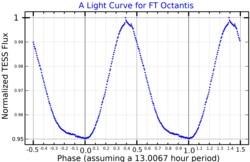TYC 9486-927-1 (also known as 2MASS J21252752-8138278) is the primary of a possible trinary star system located at a distance of 34.5 parsecs from Earth in the southern direction in the constellation of Octans. It is a BY Draconis variable, with large starspots causing it to change brightness as it rotates every 13 hours.[3]
| Observation data Epoch J2000 Equinox J2000 | |
|---|---|
| Constellation | Octans |
| Right ascension | 21h 25m 27.4805s[2] |
| Declination | −81° 38′ 27.692″[2] |
| Apparent magnitude (V) | 11.5 - 12.0[3] |
| Characteristics | |
| Spectral type | M1 V[4] |
| Variable type | BY Dra[3] |
| Astrometry | |
| Radial velocity (Rv) | 8.7±4.6[4] km/s |
| Proper motion (μ) | RA: 60.645(46) mas/yr[2] Dec.: −107.740(48) mas/yr[2] |
| Parallax (π) | 29.0266 ± 0.0401 mas[2] |
| Distance | 112.4 ± 0.2 ly (34.45 ± 0.05 pc) |
| Details | |
| Mass | 0.53[5] M☉ |
| Radius | 0.46[6] R☉ |
| Luminosity | 0.032[6] L☉ |
| Surface gravity (log g) | 4.3[7] cgs |
| Temperature | 3,490[8] K |
| Metallicity [Fe/H] | −1.3[7] dex |
| Rotation | 0.541945[3] days |
| Rotational velocity (v sin i) | 43.5±1.2[8] km/s |
| Age | 10-45[8] Myr |
| Other designations | |
2MASS J21252752-8138278, FT Octantis | |
| Database references | |
| SIMBAD | data |
TYC 9486-927-1 has rapid rotation and coronal and chromospheric activity suggestive of a young age. Observations and multi-epoch radial velocity data suggest that TYC 9486-927-1 is a single, rapidly rotating star rather than a spectroscopic or tight visual binary. However, it is still possible that TYC 9486-927-1 is an equal mass binary with a face-on orbit and close separation.[4]
The candidate secondary stellar companion is 2MASS J21121598–8128452. It is a red dwarf star of spectral class M5.5. Its projected separation from the primary would be 62,700 AU. The candidate tertiary companion is 2MASS J21192028–8145446 - of spectral class M6 or M7 and at a projected separation of 31,000 AU from the primary.[5]: 7
Planetary system
editThe planet 2MASS J21265040-8140293 orbits TYC 9486-927-1 at a projected separation of 7400 AU.[5] With a mass from 11.6 to 15 Jupiter masses, it is considered to be either a brown dwarf, or a giant planet.[9][10]
| Companion (in order from star) |
Mass | Semimajor axis (AU) |
Orbital period (days) |
Eccentricity | Inclination | Radius |
|---|---|---|---|---|---|---|
| 2MASS J2126–8140/b | 13.3 (± 1.7)[11] MJ | 6,900[8] | 328 725 000[citation needed] | — | — | — |
References
edit- ^ "MAST: Barbara A. Mikulski Archive for Space Telescopes". Space Telescope Science Institute. Retrieved 8 December 2021.
- ^ a b c d Vallenari, A.; et al. (Gaia collaboration) (2023). "Gaia Data Release 3. Summary of the content and survey properties". Astronomy and Astrophysics. 674: A1. arXiv:2208.00211. Bibcode:2023A&A...674A...1G. doi:10.1051/0004-6361/202243940. S2CID 244398875. Gaia DR3 record for this source at VizieR.
- ^ a b c d Samus, N. N.; et al. (2017). "General Catalogue of Variable Stars". Astronomy Reports. 5.1. 61 (1): 80–88. Bibcode:2017ARep...61...80S. doi:10.1134/S1063772917010085. S2CID 125853869.
- ^ a b c Torres, C. A. O.; Quast, G. R.; Da Silva, L.; de la Reza, R.; Melo, C. H. F.; Sterzik, M. (2006). "Search for associations containing young stars (SACY). I. Sample and searching method". Astronomy and Astrophysics. 460 (3): 695. arXiv:astro-ph/0609258. Bibcode:2006A&A...460..695T. doi:10.1051/0004-6361:20065602. S2CID 16080025.
- ^ a b c Jones, H R A.; Caballero, J. A.; Beamín, J. C.; Barrado, D.; Sarro, L. M.; Marocco, F.; Smart, R. L. (2019), "The Gaia Ultra-Cool Dwarf Sample – II: Structure at the end of the main sequence", Monthly Notices of the Royal Astronomical Society, 485 (3): 4423–4440, arXiv:1902.07571, Bibcode:2019MNRAS.485.4423S, doi:10.1093/mnras/stz678, S2CID 119421722
- ^ a b Gaidos, E.; et al. (September 2014). "Trumpeting M dwarfs with CONCH-SHELL: a catalogue of nearby cool host-stars for habitable exoplanets and life". Monthly Notices of the Royal Astronomical Society. 443 (3): 2561–2578. arXiv:1406.7353. Bibcode:2014MNRAS.443.2561G. doi:10.1093/mnras/stu1313. S2CID 119234492.
- ^ a b Steinmetz, M.; et al. (2020). "VizieR Online Data Catalog: RAVE 6th data release (Steinmetz+, 2020)". Vizier Online Data Catalog. Bibcode:2020yCat.3283....0S.
- ^ a b c d Deacon, N. R.; Schlieder, J. E.; Murphy, S. J. (2016). "A nearby young M dwarf with a wide, possibly planetary-mass companion". Monthly Notices of the Royal Astronomical Society. 457 (3): 3191. arXiv:1601.06162. Bibcode:2016MNRAS.457.3191D. doi:10.1093/mnras/stw172. S2CID 18220333.
- ^ Gagné, Jonathan; Lafrenière, David; Doyon, René; Malo, Lison; Artigau, Étienne (2014). "BANYAN. II. Very Low Mass and Substellar Candidate Members to Nearby, Young Kinematic Groups with Previously Known Signs of Youth". The Astrophysical Journal. 783 (2): 121. arXiv:1312.5864. Bibcode:2014ApJ...783..121G. doi:10.1088/0004-637X/783/2/121. S2CID 119251619.
- ^ Reid, I. Neill; Cruz, Kelle L.; Kirkpatrick, J. Davy; Allen, Peter R.; Mungall, F.; Liebert, James; Lowrance, Patrick; Sweet, Anne (2008). "Meeting the Cool Neighbors. X. Ultracool Dwarfs from the 2MASS All-Sky Data Release". The Astronomical Journal. 136 (3): 1290. arXiv:0806.3413. Bibcode:2008AJ....136.1290R. doi:10.1088/0004-6256/136/3/1290.
- ^ "Planet 2MASS J2126-8140". Extrasolar Planets Encyclopaedia. Retrieved 2016-01-27.
